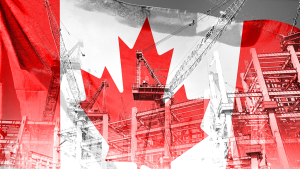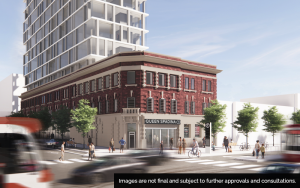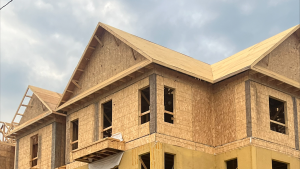ConstructConnect’s early-Summer 2017 forecasts of the Census Bureau’s put-in-place construction spending statistics are set out in the accompanying table.
The long-term historical and projected movements of ‘grand total’, ‘total residential’, ‘total non-residential’ and some key type-of-structure sub-categories are shown in the graphs.
There’s a full explanation of what constitutes the put-in-place investment numbers, and how they relate to ‘starts’, in the closing section of this article.
A quick look at the ‘grand total’ forecasts for 2017 (+7.2% y/y), 2018 (+7.3%) and 2019 (+7.2%) suggests that stability in construction is expected over the next two-and-a-half years.
That’s deceptive. One needs to look deeper into the numbers to learn that considerable variation will occur according to type-of-structure sub-categories.
For example, ‘total residential’ construction will do better up front, then gradually decelerate: +15.2% in 2017; +11.5% in 2018; and +9.6% in 2019.
‘Total non-residential’ will move in an opposite manner, beginning slowly, but then picking up speed over the next couple of years: +1.9% in 2017; +4.1% in 2018; and +5.2% in 2019.
Residential construction’s big jump in 2017 is largely predicated on how strong the category has already performed year to date. January-to-April 2017 residential PIP investment is +11.3% versus January-to-April 2016. Furthermore, in the latest three months, residential investment has surged ahead by +35.0% (annualized) compared with the prior three months.
Table 1: U.S. Construction Spending (put-in-place investment)
(billions of “current” $s)
| Type of Construction: | 2012 | 2013 | 2014 | 2015 | 2016 | 2017 | 2018 | 2019 |
| Grand Total | 850.5 | 906.4 | 1,005.6 | 1,112.4 | 1,164.5 | 1,248.1 | 1,339.1 | 1,435.2 |
| (year versus previous year) | 6.6% | 11.0% | 10.6% | 4.7% | 7.2% | 7.3% | 7.2% | |
| Total Residential | 276.1 | 329.2 | 374.9 | 440.3 | 464.3 | 534.9 | 596.4 | 653.7 |
| 19.3% | 13.9% | 17.4% | 5.5% | 15.2% | 11.5% | 9.6% | ||
| Total Nonresidential | 574.4 | 577.1 | 630.8 | 672.2 | 700.1 | 713.2 | 742.7 | 781.5 |
| 0.5% | 9.3% | 6.6% | 4.2% | 1.9% | 4.1% | 5.2% | ||
| Total Commercial/for Lease | 96.0 | 104.6 | 126.2 | 143.8 | 170.8 | 182.5 | 190.9 | 197.8 |
| 9.0% | 20.6% | 14.0% | 18.8% | 6.8% | 4.6% | 3.6% | ||
| Lodging | 10.8 | 13.5 | 16.7 | 21.7 | 27.2 | 29.5 | 30.5 | 30.6 |
| 24.4% | 24.1% | 29.8% | 25.3% | 8.2% | 3.6% | 0.4% | ||
| Office | 37.8 | 38.0 | 46.6 | 55.2 | 69.0 | 74.4 | 78.4 | 82.1 |
| 0.5% | 22.7% | 18.5% | 25.1% | 7.8% | 5.3% | 4.7% | ||
| Commercial/Retail | 47.3 | 53.2 | 62.8 | 66.9 | 74.5 | 78.6 | 82.0 | 85.1 |
| 12.3% | 18.2% | 6.5% | 11.4% | 5.4% | 4.4% | 3.7% | ||
| Total Institutional | 157.0 | 148.1 | 147.9 | 156.5 | 163.7 | 169.5 | 177.9 | 186.9 |
| -5.7% | -0.1% | 5.8% | 4.6% | 3.6% | 4.9% | 5.1% | ||
| Health Care | 42.5 | 40.7 | 38.6 | 40.7 | 41.4 | 41.9 | 44.7 | 48.0 |
| -4.4% | -5.0% | 5.4% | 1.5% | 1.4% | 6.6% | 7.4% | ||
| Educational | 84.7 | 79.1 | 79.7 | 83.5 | 88.7 | 91.9 | 95.9 | 99.9 |
| -6.6% | 0.8% | 4.8% | 6.2% | 3.7% | 4.3% | 4.2% | ||
| Religious | 3.8 | 3.6 | 3.4 | 3.7 | 3.8 | 3.3 | 3.3 | 3.3 |
| -6.7% | -5.7% | 8.3% | 2.4% | -11.7% | -1.5% | 1.4% | ||
| Public Safety | 10.4 | 9.5 | 9.4 | 8.7 | 8.1 | 8.5 | 9.1 | 9.7 |
| -8.9% | -0.7% | -7.5% | -6.7% | 4.7% | 6.3% | 6.7% | ||
| Amusement and Recreation | 15.5 | 15.2 | 16.8 | 19.9 | 21.8 | 23.8 | 25.0 | 26.0 |
| -1.8% | 10.3% | 18.5% | 9.5% | 9.4% | 4.9% | 4.1% | ||
| Total Engineering/Civil | 273.7 | 273.9 | 298.0 | 293.6 | 290.5 | 291.5 | 306.6 | 327.0 |
| 0.1% | 8.8% | -1.5% | -1.1% | 0.3% | 5.2% | 6.6% | ||
| Transportation | 37.9 | 39.5 | 42.0 | 45.6 | 42.6 | 43.3 | 44.9 | 47.3 |
| 4.2% | 6.5% | 8.4% | -6.4% | 1.6% | 3.6% | 5.5% | ||
| Communication | 16.2 | 17.8 | 17.3 | 20.5 | 19.7 | 20.2 | 21.2 | 22.3 |
| 10.0% | -2.7% | 18.6% | -3.9% | 2.7% | 4.6% | 5.6% | ||
| Power | 97.4 | 93.3 | 110.1 | 92.4 | 95.8 | 98.9 | 104.5 | 112.6 |
| -4.2% | 18.0% | -16.0% | 3.6% | 3.3% | 5.6% | 7.8% | ||
| Highway and Street | 80.5 | 81.4 | 84.7 | 89.8 | 90.8 | 93.7 | 99.7 | 106.6 |
| 1.0% | 4.2% | 5.9% | 1.1% | 3.2% | 6.4% | 7.0% | ||
| Sewage and Waste Disposal | 22.3 | 22.4 | 23.2 | 24.3 | 22.1 | 18.9 | 19.4 | 20.2 |
| 0.7% | 3.3% | 4.8% | -8.8% | -14.7% | 2.8% | 4.0% | ||
| Water Supply | 13.2 | 13.6 | 13.4 | 13.1 | 11.9 | 10.1 | 10.4 | 10.9 |
| 2.9% | -1.6% | -2.0% | -9.2% | -15.4% | 3.3% | 4.8% | ||
| Conservation and Development | 6.2 | 6.0 | 7.3 | 8.0 | 7.6 | 6.4 | 6.6 | 7.0 |
| -4.2% | 22.5% | 9.2% | -4.3% | -16.5% | 4.2% | 4.6% | ||
| Total Industrial/Manufacturing | 47.7 | 50.5 | 58.6 | 78.2 | 75.1 | 69.8 | 67.2 | 69.8 |
| 5.9% | 16.0% | 33.3% | -3.9% | -7.1% | -3.6% | 3.8% |
"Current" means not adjusted for inflation.
Data source: U.S. Census Bureau.
Chart: ConstructConnect.
(put-in-place investment)

Chart: ConstructConnect
Graph 2 illustrates the huge shortfall (i.e., relative to ‘fitted’ trend line) that occurred in housing construction from 2009 through 2014 inclusive. More than multi-family housing, the single-family market has enormous potential – depending on the degree to which millennials, when they form their families, move out of downtown cores and, take up residence in the suburbs. Many (but by no means all) of them will want to emulate their parents and grandparents.
(put-in-place investment)

Chart: ConstructConnect
Graph 3 showcases an outlook for total non-residential construction that is in keeping with its long-term trend line. But there will be divergences at a more granular level.
(put-in-place investment)

Chart: ConstructConnect
For example, within non-residential building work, ‘lodging’ (Graph 4), ‘office buildings’ (Graph 5) and ‘commercial/retail’ (Graph 6) have all recorded bullish year-to-date percentage changes through April 2017, of +11.0%, +17.1% and +12.6% respectively. But it’s also true that their latest three-month performances, relative to prior three months, have turned negative, at -9.8%, -17.9% and -1.3% respectively. (For the article featuring the latest ‘PIP speeding-up/slowing-down’ table, please click here.)
The hotel/motel (or ‘lodging’) segment is a highly cyclical sub-category of construction. Once one owner spends money to fix up a property, or to add room capacity, there is a ‘bandwagon effect’ whereby numerous rivals will feel the need to take action as well in order to stay competitive.
‘Lodging’ construction has been in an up-cycle of late, but it is about to flatten out.
To its advantage, ‘office building’ construction since 2013 has been swept up in a big push to build mixed-use projects. As office-space vacancy rates tighten further, tower construction will continue to climb, but at a more relaxed pace.
Many well-known ‘bricks and mortar’ shopkeepers are being forced to close locations, as they lose business to the relentless advance of Internet platforms. Still, much of retail remains ‘hands on’ and consumer spending, driven by today’s low unemployment rate (4.3%) and good earnings growth (+2.5% y/y for ‘all jobs’ on average), will justify more square footage – just not in the same large incremental stages as in the past.
(put-in-place investment)

Chart: ConstructConnect
(put-in-place investment)

Chart: ConstructConnect
(put-in-place investment)

Chart: ConstructConnect
‘Total institutional’ starts (Graph 7) are projected to continue along a path similar to what was established in 2016 (+4.6%). In 2017, they will be +3.6%; in 2018, +4.9%; and in 2019, +5.1%.
(put-in-place investment)

Numbers for this series prior to 2002 are no longer consistent with more current data.
Chart: ConstructConnect
‘Health care’ construction (Graph 8) will stay bed-ridden in 2017 (+1.4%), but it will become revitalized in 2018 (+6.6%) and 2019 (+7.4%). First, the sector needs Congress to provide a stable framework – i.e., with respect to maintaining, modifying, repealing or replacing Obamacare – upon which health care providers can craft their capital spending plans.
(put-in-place investment)

Numbers for this series prior to 2002 are no longer consistent with more current data.
Chart: ConstructConnect.
With the demographic cohort (i.e., youths aged 4 to 18) that drives elementary and high school enrolments stuck in neutral for a number of years to come, and sign-ups by college- and university-age students in decline, – on account of the good jobs market, plus a dearth of foreign student registrations − enthusiasm concerning the outlook for educational facility construction (Graph 9) should be tempered: +3.7% in 2017; +4.3% in 2018; and +4.2% in 2019.
(put-in-place investment)

Numbers for this series prior to 2002 are no longer consistent with more current data.
Chart: ConstructConnect
The ‘total engineering’ PIP forecast (Graph 10) is calling for a return to trend line by 2019. There were declines in engineering construction spending in 2015 (-1.5%) and 2016 (-1.1%) and 2017 (+0.3%) will only barely break above zero. But prospects are improving for ‘power’ work and infrastructure spending and 2018 (+5.2%) and 2019 (+6.6%) will escape overcast skies and emerge into sunshine.
(put-in-place investment)

Numbers for this series prior to 2002 are no longer consistent with more current data.
Chart: ConstructConnect
Graph 11 clearly demonstrates a long-term upward progression in put-in-place spending on ‘power’ projects. The ‘power’ designation includes electricity generation and oil and natural gas pipelines, extraction plants and refineries. Having received the new President’s blessing, the Keystone XL pipeline expansion will add substantial dollars to this sub-category in the years ahead. Also, the U.S. is now exporting liquefied natural gas – meaning a need for cooling plants and port facilities − and Washington is more inclined to adopt policies favorable to fossil fuel exploration and development.
Much of the financing for the nation’s roadway and bridge construction is derived from the Highway Trust Fund, which is bolstered by the federal fuel tax, set at 18.4 cents per gallon of gasoline (and a little higher for diesel). But there’s a problem. The federal fuel tax has not been raised since 1993, 20 years ago. During the intervening period, the cost of construction has risen on account of inflation. Also, vehicles have become far more fuel efficient. It seems there’s always a struggle to keep the Highway Trust Fund topped up.
(put-in-place investment)

Chart: ConstructConnect
Thankfully, there’s another significant source of cash for street and bridge work, state fuel taxes. Worried about safety issues due to crumbling structures and anxious to relieve commuter bottlenecks, quite a number of state legislatures are becoming more aggressive in raising their fuel tax levies. Graph 12 shows that whatever impediments may exist with respect to sources of financing, somehow the means are found to keep put-in-place dollars flowing with surprising consistency into highway and street construction.
The GOP’s promised infrastructure spending initiative may appear stalled at the moment, but it has too much support not to eventually burst forth. The spending on ‘highways and streets’ will display an upward arc: +3.2% in 2017; +6.4% in 2018; and +7.0% in 2019. And the dollars going towards ‘sewage and water disposal’, in decline in 2017 (-14.7%), will recover in 2018 (+2.8%) and 2019 (+4.0%). Water supply work will display a similar pattern: 2017, -15.4%; but 2018, +3.3%; and 2019, +4.8%.
(put-in-place investment)

Numbers for this series prior to 2002 are no longer consistent with more current data.
Chart: ConstructConnect
Finally, there’s the outlook for capital spending by manufacturers to consider. Year-to-date, the sector is -8.3% and the latest three-months-over-previous-three-months figure (annualized) is almost the same, at -7.7%. Through lowering the corporate tax rate, providing incentives for firms to bring money home from abroad, and perhaps adopting some protectionist tariff measures, President Trump has spelled out his plans to achieve a turnaround in the fortunes of production-line enterprises. But headwinds with respect to automation, cheap and abundant labor in alternative offshore locations and a relatively high-valued U.S. dollar will stay troublesome.
There will be an improvement in manufacturing put-in-place investment, but it is likely to be gradual and mild: 2017, -7.1%; 2018, -3.6%; but by 2019, +3.8%.
(put-in-place investment)

Chart: ConstructConnect
Put-in-place versus ‘Starts’
Before ending this article, there’s another matter – initially mentioned a couple of sentences down from the opening − that warrants discussion.
ConstructConnect gathers and publishes ‘starts’ statistics. And calculates and posts forecasts of the ‘starts’ data.
Readers often confuse the ‘starts’ and the government’s put-in-place investment numbers. They are quite different statistical series. And while there is a lead-lag relationship between the two, the former will never have a dollar volume as high as the latter.
The following discusses ‘starts’ versus capital spending in more detail.
The Census Bureau’s put-in-place (PIP) statistics are like progress payments or ‘work-in-process’ payments as a project proceeds.
ConstructConnect’s figures are built-up. They are based on specific project-value estimates, with the full dollar amount (and square footage) entered at the beginning. (That’s why they are sometimes described as ‘lumpy’.)
Consider a $60 million office tower for which ground is broken this month. It would appear in the Census Bureau’s numbers as spending of approximately $15 million this year; $25 million next year; and the final $20 million in 2019.
For ConstructConnect’s starts, the whole estimated value ($60 million) would be entered in June 2017.
Due to the staged timing, inflation is more likely to enter into the PIP numbers.
Graphs of the starts lead the PIP investment numbers. A cyclical peak for starts will appear before a cyclical peak for the PIP series. The same goes for cyclical troughs.
The starts are also more volatile (i.e., because they are ‘lumpy’). Their cyclical swings are far greater. In technical terms, their amplitudes are wider.
What is perhaps most important to understand, however, is that the volume of starts is unlikely to ever ascend to the same lofty heights as the PIP numbers.
The chief reason is because the PIP numbers must cover the ‘universe’. The Census Bureau makes estimates, or what are called ‘imputations’, to fill in all the blanks.
The Census Bureau is required to generate all-encompassing numbers to support two crucial line items − i.e., investment in residential and non-residential structures – in the nation’s gross domestic product (GDP) calculation.
ConstructConnect’s starts, being based on actual planned projects discovered and documented and entered into an extensive database by its teams of researchers, are ‘solid’ but not all inclusive. Furthermore, ConstructConnect makes no estimations for missing material.
While every effort is made at minimization, there are gaps in the ‘starts’ coverage – according to some types of structure and some regions.
Certain owners won’t reveal the extent of what they are building. And obtaining all-encompassing information on energy projects has traditionally been done by others.
Most important, renovation work is difficult to identify. To understand how significant this is, consider that approximately half of all residential construction is renovation activity.
The bottom line is that the two series bear a lead (starts) to lag (PIP) relationship with each other, but they can’t truly be equated.










Recent Comments
comments for this post are closed